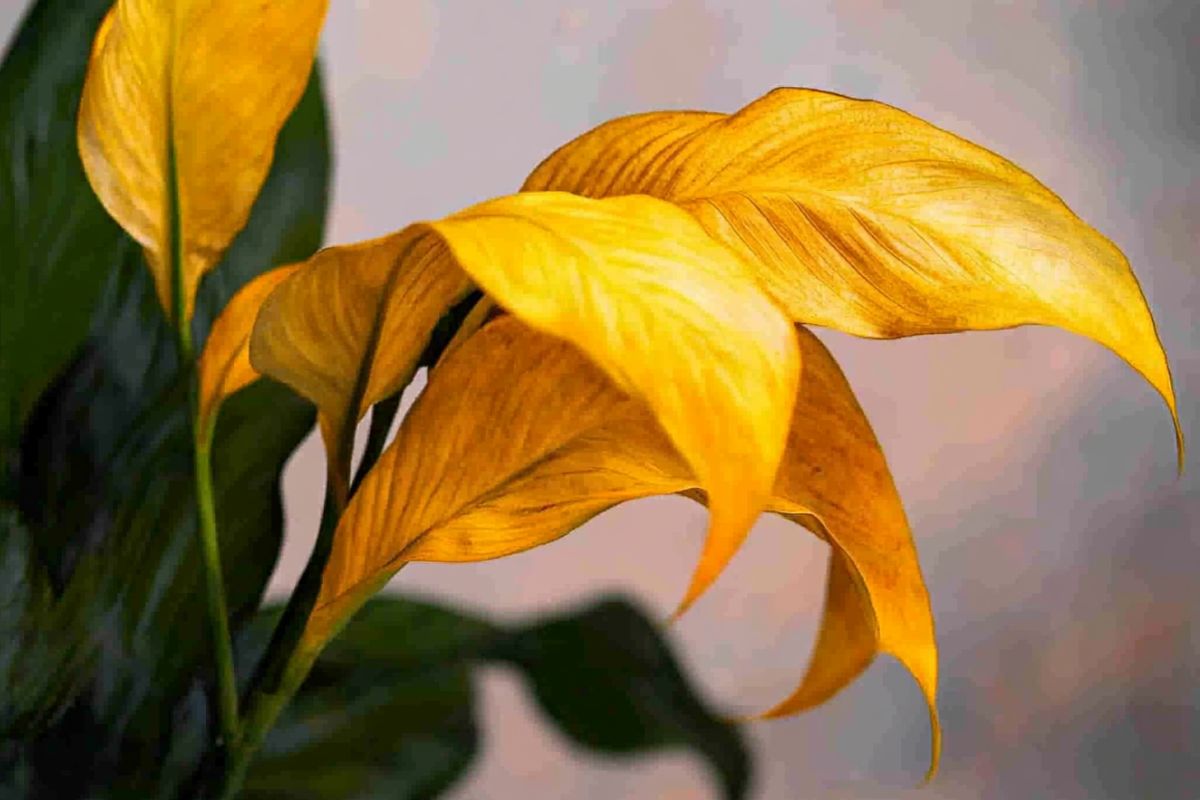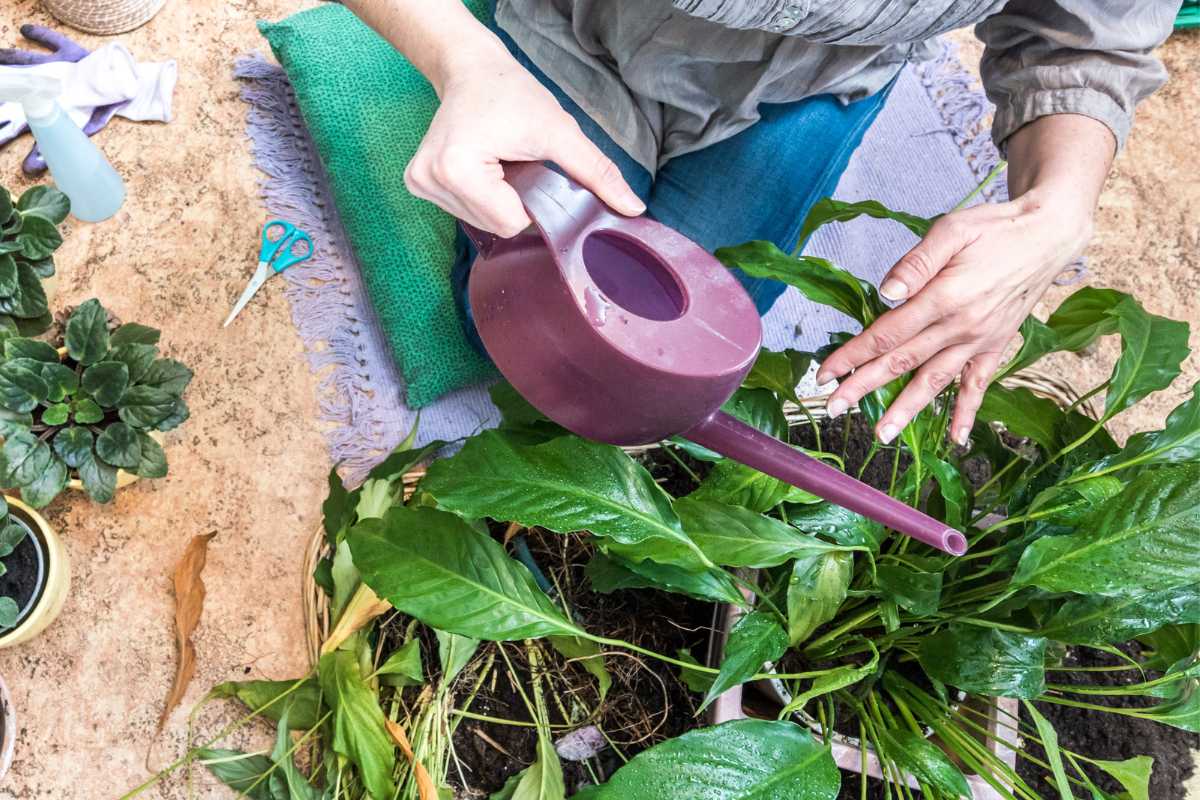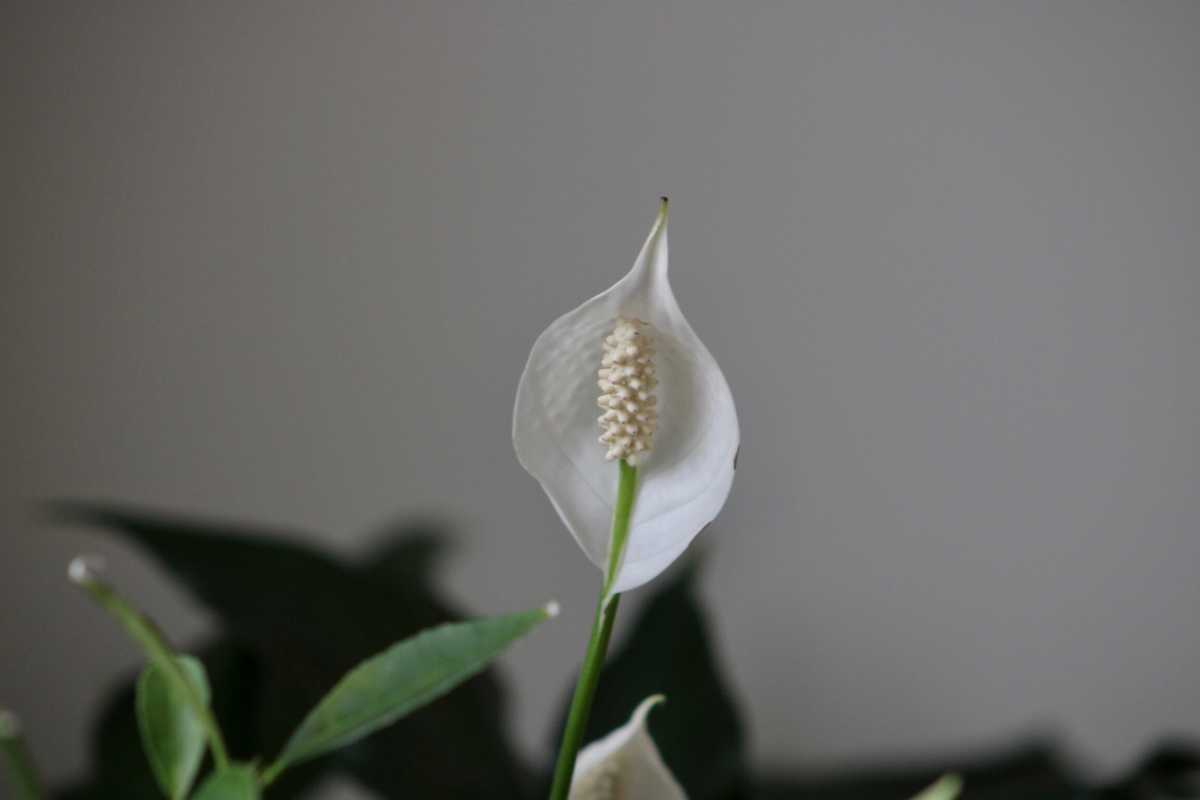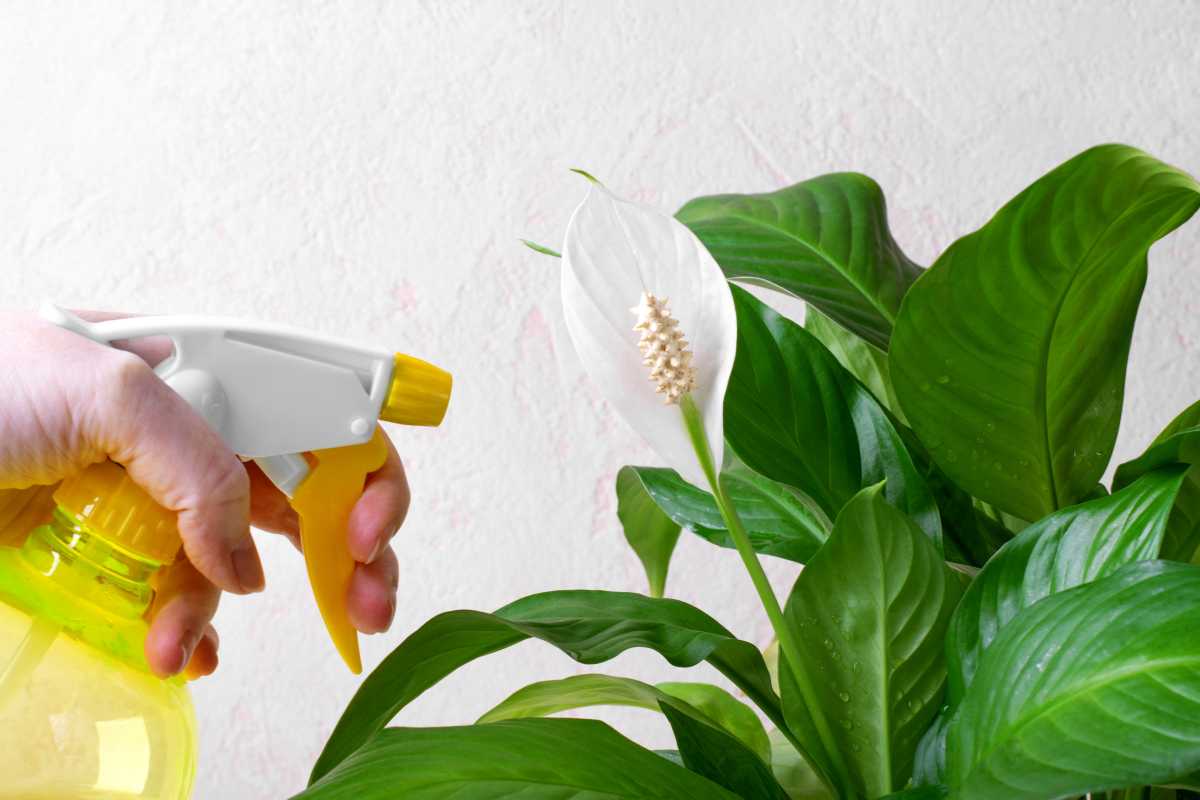Home gardeners love beautiful houseplants, especially those that flower. One low-maintenance, elegant plant that brightens up any space with its green foliage and white flowers is the peace lily or spathiphyllum.
This delightful, popular houseplant has very few needs, but nonetheless may exhibit signs or symptoms of stress. One common symptom is the peace lily leaves turning yellow.
Don’t worry yet! Let’s take a look at the most common reasons for yellow leaves on a peace lily and how to resolve the problems that cause this.
- Related article: Beginner’s Guide to Growing Peace Lilies
7 Key Takeaways on Yellow Peace Lily Leaves
- Yellow leaves on a peace lily often hint at natural aging. Snipping these old leaves not only freshens the look but also encourages new growth, inviting vibrant leaves.
- Overwatering lurks as a sneaky enemy, suffocating the roots in soggy soil. Ensure proper drainage and wait until the top soil is dry before watering again to keep your plant healthy.
- Conversely, yellowing leaves can cry for help from underwatering. Sticking to a steady watering routine is essential for keeping your peace lily lively and green.
- Water quality plays an important role! Hard tap water, filled with minerals and chlorine, can stress your peace lily. Switching to filtered or distilled water can greatly improve its health.
- Peace lilies love bright, indirect light. Too much direct sun can burn their tender leaves, while too little can lead to yellowing. Finding the perfect light balance is key.
- Yellowing leaves might show nutrient shortages, especially nitrogen, magnesium, or iron. Using a diluted fertilizer during the growing season can help bring back your plant’s bright colors.
- Keep an eye out for bugs like aphids or spider mites and root diseases. These troublemakers can cause yellow leaves, so quick action is needed for your peace lily to grow again.
Reasons Why Peace Lily Leaves Turn Yellow

A healthy peace lily will boast lance-shaped, dark green leaves that emerge directly from the soil bed. Although resilient plants, there are reasons why the foliage may turn yellow.
1. Natural Aging
In the case of natural aging, there’s not much to do. As the peace lily plant ages, the leaves will turn yellow and eventually die off.
Solution:
When the plant’s older foliage turns yellow, trim off the yellowed leaves with a clean, sharp cutting tool or scissors. It’s important that your cutting tool be clean to avoid spreading disease or infection to other houseplants. Dull cutting blades can also damage the plant at the point of the cut.
I personally use the Bypass Pruning Shears for professional pruning, and they work great for all my plants, including my peace lily. Their adjustable feature fits any hand size comfortably, making them easy to use for precise cuts. You can purchase them easily online through Amazon.
2. Overwatering

Overwatering is the number one reason that peace lily leaves turn yellow. Whether you have given your plant too much water, or the plant’s container has insufficient drainage, the damage will be the same.
When there’s excess water, the plant’s root system will end up sitting in water, and oxygen will not get to the roots. The plant will drown and root rot will set in.
Solution:
It may be necessary to repot your plant. Remove the peace lily from the wet soil. Trim off any damaged roots and let healthy roots dry a bit before placing the plant in fresh, well-draining soil.
- Learn more: Guide to Peace Lily Repotting
Check your container so that each drainage hole is not blocked and there are enough holes too. Only water your plant when necessary, generally weekly or maybe twice weekly in warmer weather. The top half of the soil bed should be dry before you water anew.
3. Underwatering
If you have forgotten to water your plant, yellow leaves can indicate that your plant is very thirsty. A peace lily will usually hint that it needs a drink with discolored leaves.
Their leaves will also begin wilting or drooping. If you water at the first sign of wilting, these leaves on peace lilies will usually spring back to life within a day.
An occasional missed watering will not damage them, even if not good for the plant’s overall health. However, should the plant be denied water over long periods of time or repeatedly, it will suffer more serious damage and its leaves may turn from their beautiful green color to yellow.
Solution:
Remove yellow leaves and place your plant on a regular watering schedule to avoid underwatering in the future.
4. Poor Water Quality

The peace lily, known for its hardiness, can surprisingly react poorly to water quality issues. If your water is hard—rich in minerals like calcium—this can lead to distress, manifesting as yellowing leaves. It’s a subtle yet serious sign that something’s off.
Many people rely on tap water, unaware that it often contains these minerals and added chlorine, both of which can affect your plant’s vitality.
Solution:
To mitigate this, allow your tap water to sit out for a full 24 hours before applying it to your peace lily. This simple act lets the chlorine evaporate, making it gentler for your plant. You can also use a Tap Water Conditioner to instantly neutralize harmful chemicals.
For even better water quality, consider alternatives like distilled water, filtered water, or collected rainwater.
5. Lighting Issues

One of the reasons that peace lilies are so popular in homes, offices, and apartments is that they adapt exceptionally well to low and medium-light conditions.
They naturally thrive in shady conditions, but they need light for photosynthesis. They do enjoy being placed in indirect bright light the most because they are tropical plants that call the rainforest floor home.
If they are left in the dark, the leaves will turn yellow. With dim light, the leaves will continue to be a lush shade of green. However, it is probable that the plant may not produce flower blooms.
At the opposite end of the spectrum is too much direct light. Too much light can turn leaves yellow, and hot, direct sunlight will scorch the foliage with brown spots and turn them into brown leaves.
Solution:
To prevent either, simply position your plant in a place with partial shade and bright indirect light.
- Read more: Leaves of Peace Lilies Turning Brown
6. Temperature Issues and Drafts
As a tropical plant, the peace lily likes a temperature range between 65° and 85° Fahrenheit, making it an ideal indoor plant. They will not survive in temperatures that drop below 45°F.
They do not like the cold, so placing them on a cold balcony, patio, deck, or porch, or positioning them by a drafty window or doorway may cause leaves to turn yellow.
Solution:
To protect your plant and prevent the yellowing of leaves due to temperature issues, place your plant in a comfortably heated room in colder weather and far from cold drafts.
7. Nutrient Deficiencies

The peace lily is a tough plant and doesn’t need much fertilizer, which is great! However, don’t be fast into thinking it can be ignored. Even this hardy plant has basic needs.
Yellowing often means the plant is low on nitrogen, an important nutrient for vibrant leaves. But wait — magnesium and iron deficiencies can also cause yellowing.
Sometimes, yellow leaves with green veins hint at too much light. If that’s the case, move your plant to a shadier spot before assuming it needs more food.
Solution:
You can add a diluted fertilizer each month during the growing season. Be careful with overfertilizing, as it can hurt your peace lily.
When in doubt, dilute your fertilizer to half the suggested strength. And if you repot or move your peace lily, it might go into shock, causing yellow leaves. Give it time to adjust, and soon it will bounce back.
8. Pest Infestations
Peace lilies are generally strong plants, but they aren’t completely safe from pests. Watch out for aphids and mealybugs; they can sneak in and cause trouble. If your peace lily is too dry, spider mites might decide to move in. When the leaves start turning yellow, it often means the problem is getting serious.
Solution:
To fight back, use an insecticidal soap spray and remember to wipe down the leaves thoroughly. Another handy option is neem oil, an organic remedy that can help keep those pesky bugs away.
9. Diseases
Unfortunately, the peace lily is susceptible to disease, and the two principal diseases are Phytophthora parasitica fungi and Cylindrocladium spathyphilli. There are no cures.
These diseases live within the soil bed and will attack the plant at the roots, causing them to rot. If yellow leaves appear as a symptom of these two diseases, you will probably need to dispose of the plant.
Solution:
To prevent these diseases from developing, allow the soil to dry out between waterings.
General Tips to Prevent Lily Leaves from Turning Yellow

Keep in mind these tips on peace lily care to help prevent yellow leaves and revive your plant.
- Remove yellow leaves as they are weakened and cannot turn green again. They may contribute to other problems too, so it’s best to prune them.
- Just because a leaf is yellow does not mean that you need to dispose of the entire plant. Prune the yellow leaves and wait to see if new growth appears.
- Always clean and sterilize gardening tools to prevent the spread of infections or infestations.
- Don’t ignore the appearance of yellow leaves. Attempt to discover the cause and then move to resolve the issue.
- Once you have diagnosed a cause and intervened, expect to see your peace lily return to a healthy appearance within a couple of weeks. If this does not happen, re-evaluate the cause of the yellowing leaves.
Peace Lily Leaves Turning Yellow Final Thoughts
Caring for your peace lily means paying close attention to its needs. When those yellowing leaves appear, they often signal deeper troubles. Whether it’s due to natural aging, too much water, or missing nutrients, identifying the root of the problem is essential for reviving your plant.
Make it a routine to check the environment, watering schedule, and soil quality. These factors are vital for keeping those lush green leaves looking their best. And don’t forget about light and temperature; peace lilies love moderate conditions!
If you quickly address those yellow leaves and practicing proper care techniques, you can enjoy a flourishing peace lily for years to come. With a touch of patience and effort, your peace lily can bounce back, bringing beauty and life to your space!
Peace Lily Leaves Turning Yellow FAQs
1. What Causes Peace Lily Leaves to Turn Yellow in Cold Temperatures?
Peace Lily leaves may turn yellow when exposed to cold temperatures. These plants thrive in warm environments, and sudden drops in temperature can stress them. It’s essential to keep them in a stable, warm location away from drafts to maintain their health.
2. How Does Liquid Fertilizer Affect Peace Lily Leaf Color?
Improper use of liquid fertilizer can lead to nutrient issues, causing yellowing leaves. Over-fertilization may burn the roots, while under-fertilization results in nutrient deficiencies. Always follow the recommended dosage to support healthy growth.
3. Can Indirect Sunlight Help Prevent Yellowing Leaves?
Yes, indirect sunlight is crucial for a Peace Lily’s health. Direct sunlight can scorch the leaves, leading to yellowing. Position your plant where it receives bright, filtered light for optimal growth and to avoid leaf discoloration.
4. How Do Browning Leaves Relate to Nutrient Issues in Peace Lilies?
Browning leaves often indicate nutrient deficiencies or excesses. Yellowing may precede browning if the plant lacks essential nutrients or receives too much fertilizer. Regularly check soil moisture and nutrient levels to keep your Peace Lily healthy.
5. Why Is Moist Soil Important for Peace Lily Health?
Maintaining moist soil is vital for Peace Lilies, as dry conditions can lead to yellowing and falling leaves. These plants prefer consistently damp soil but avoid overwatering, which can lead to root rot. Use purified water to improve their overall health and support proper humidity levels. Consider using sheer curtains to filter light and maintain humidity for your plant.
Learn more about the peace lily through these informative reads:




